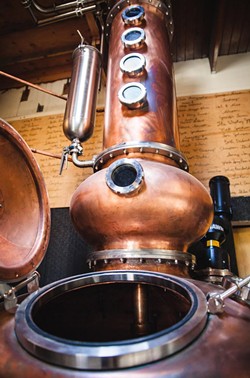[
{
"name": "Top Stories Video Pair",
"insertPoint": "7",
"component": "17087298",
"parentWrapperClass": "fdn-ads-inline-content-block",
"requiredCountToDisplay": "1"
}
]
Making a shot of whiskey is a tough job. There are lots of rules laid down by the federal government to make sure "American whiskey" is precisely what the world expects it to be: at least 51 percent fermented grain (corn if you want to call it Bourbon), distilled to no more than 80 percent alcohol by volume and aged at least two years in barrels made of charred virgin oak.
If you want to make environmentally friendly whiskey, it's even tougher. According to Amy and Steve Bohner of Alchemy Distillery in Arcata, you must adopt an additional set of rules. For starters, lower your energy footprint, use organic ingredients and send little or no waste to the landfill.
"We live in Arcata — we're environmentalists," says Steve Bohner, flashing a smile through his ZZ Top-style beard. "Generations after us will appreciate that we took the time ... ."
The Bohners make a living as "green builders" but aspire to be green whiskeymakers, concocting their first planet-pleasing wheat whiskey batch in 2016. They plan to release that 2 year old from its oak barrel over Memorial Day weekend.
In the meantime, they've been making un-aged "clear whiskey" and award-winning gin under the Boldt brand in their distillery behind Alchemy Construction.
Here are the seven steps to make whiskey, complete with Alchemy's eco-minded rules of engagement.
1. Get your grain. Buy local, as much as possible, says Amy Bohner. What you can't get in Humboldt, get from Northern California or Oregon. You cut out a lot of trucking, with all the accompanying petroleum costs and carbon emissions. Go to Hindley Ranch in the Mattole Valley, 80 miles away. Forget cheaper grains from Indiana; buy from Camp Grant Ranch along Avenue of the Giants, 54 miles away.
Organic grain is best. Just say "no" to pesticides and genetic modification if you want to preserve the planet's precious topsoil and heirloom plants.
If you can, repurpose used grain. Alchemy snags day-old bagels from up the street. Los Bagels routinely donates stale product to a local pig farmer and agreed to let the Bohners have the varieties best suited for whiskey: plain, multigrain, poppy seed and sesame seed. The pigs will happily get the grain later in a form known as "spent mash."
2. Mill your grain. Steve Bohner has a rule about buying American equipment: Do it. Shipping from China burns a lot of fossil fuel. Use re-purposed gear whenever possible, like a wood chipper off Craigslist Alchemy uses to mill stale bagels. Or use a friend's mill — Rhonda Wiedenbeck also buys wheat from Hindley Ranch and has a mill for her business, Beck's Bakery. When you buy your own Sasquatch roller mill, buy American.
3. Cook. Your local or re-purposed grain needs to be cooked in water between 150-190 degrees to convert starches to sugar. Procure a U.S.-made cooker from Kentucky. Instead of running fresh drinking water through cooling coils in the cooker, keep re-circulating the water you've got stored in the 3,000-gallon tank you picked up from the neighboring scrapyard.
4. Ferment. Add yeast to your sugary mash and move it into your U.S.-made fermenter for three to five days. The yeast will eat the sugar and convert it into alcohol.
5. Distill. Move the mash into your Kentucky-made still and boil until steaming. Alcohol turns to steam before water, so you can condense it back to into liquid in the bell-shaped separation tank, or "spirit safe." Donate the spent mash to a farmer (remember those hungry pigs?) instead of sending it off to the landfill or trying to flush it into the sewer. The Bohners trade their mash to an area farmer for eggs, vegetables or even a whole pig.
6. Store the whiskey. Now you can bottle your un-aged clear whiskey and sell it directly to customers — up to three bottles per customer per day. Use washable glasses and re-usable glass straws for your tastings. It's hard to find local bottle-makers so you might have to buy them from out of state.
If you're determined to make straight whiskey by aging it two years or more, you must buy charred oak barrels. Barrels made from sustainably harvested, organic oak cost three times more than the mass-produced variety. Amy Bohner says bite the bullet.
"Our customers are willing to pay a little more for a handcrafted, local product," she says. "It's not a marketing scheme — we all believe it's better for the next generation."
Alchemy tries to make up part of the added barrel costs by procuring re-purposed barrel racks for stacking and letting local breweries give the single-use barrels a recycled life storing beer.
7. Sell to customers. Federal regulations require whiskeymakers to sell product to retailers and taverns through licensed distributors. You'd prefer to haul it around in a Prius but it's out of your hands. Alchemy uses a local beer distributor. They've found markets in Oregon and there's always the temptation to sell the Boldt brand nationwide.
That would take a lot of fossil fuel.
"Our intention is for the distillery to be our only job one day," says Steve Bohner, who still pays his bills with Alchemy Construction. "If there's enough interest — sales — on the West Coast, then we're done. If we have product sitting on pallets, we'll reach out further."
Speaking of...
-

Butterflies, Real Estate Mysteries and Pop-up Dining
Jan 26, 2024 -

Alchemy's Pop-up Magic
Jan 25, 2024 -

NCJ Preview: Food Waste Recovery, Local Native Art
Nov 5, 2022 - More »
more from the author
-
Bottled Up at Tomaso's
Tom Pagano looks to sell the local sauce and distribution outfit
- Feb 14, 2019
-
Quinoa's Boom and Bust
Humboldt farmers face uncertain future
- Sep 27, 2018
-
Deco Redux
Eureka Theater Seeks a New Golden Age
- Jul 15, 2018
- More »

































